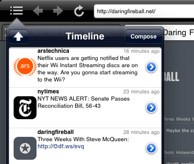Biz: Newspaper pulse check: Why one paper’s circulation skyrocketed
- The newspaper is doing OK right now. Not great, just OK. In the past six months, that gray newsprint behemoth did OK, according to the Audit Bureau of Circulation, with the top two papers gaining some ground and most of the top five staying roughly in the same order. However, the way that the group analyzed the data changed this time around — deciding, instead of focusing just on paid circulation, to emphasize “average circulation,” which includes separate editions under the umbrella of a certain brand. The numbers caused one paper to rocket into the top five and one to fall out. See if you can guess by the numbers below:
- 2.1 million daily circulation for the top-ranked Wall Street Journal
- 1.8 million average daily circulation for the still-second-place USA Today
- 916,911 average daily circulation for the freshly-paywalled New York Times
- 605k average daily circulation for the Los Angeles Times
- 577k average daily circulation for the San Jose Mercury News
- 550k average daily circulation for the Washington Post source
- » A few things of note: If you guessed that the San Jose Mercury News benefited greatly from the change in data, you’re correct — MediaNews treats each newspaper on this page as an “edition” of the Mercury News (which seems a little number-inflating). Other notes: This data covers the daily circulation for the past six months — a period which only includes a tiny bit of the New York Times’ post-paywall circulation (so come back in six months to see if it was a success). But e-editions are doing quite well, especially for the Wall Street Journal and Detroit Free Press. One last thing: The numbers only cover paid newspapers, not free ones. (photo by Brent D. Payne)







